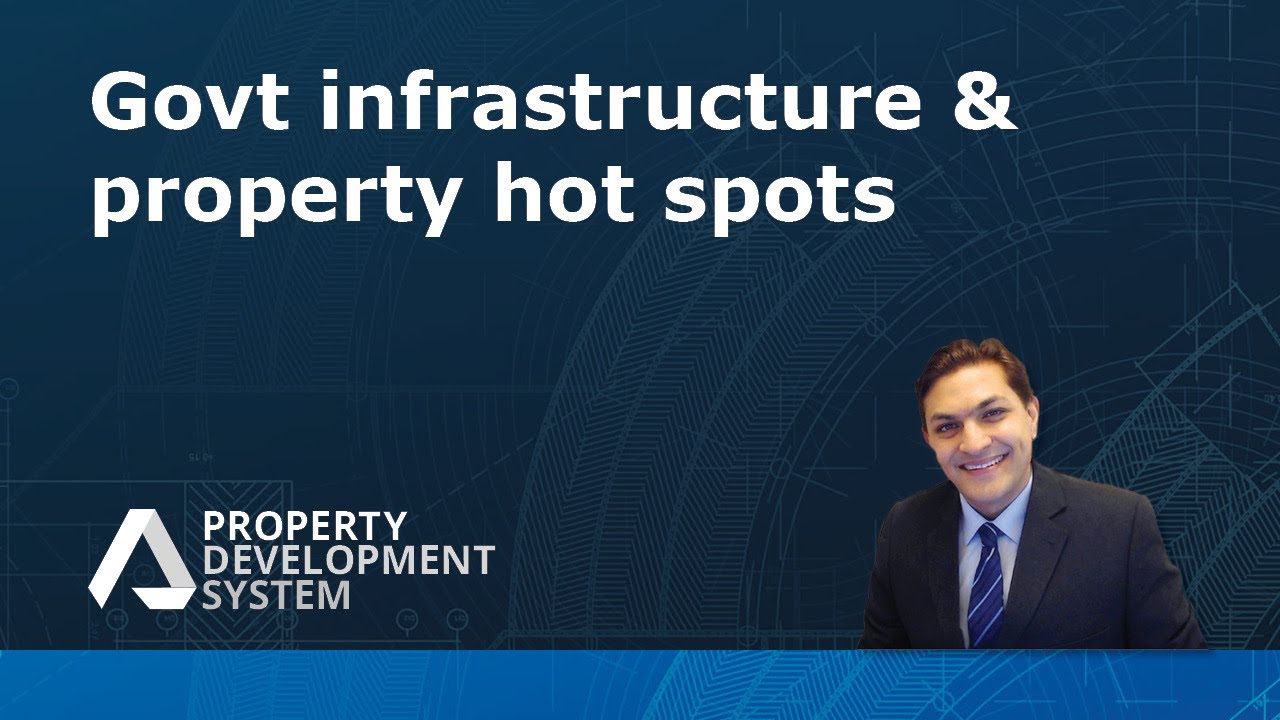Govt Infrastructure
Govt Infrastructure
Important
This video is from the past, but it covers key metrics that help explain market trends and their effect on property prices.
Here, you will explore the significance of government spending on infrastructure as a key indicator of capital growth, highlighting how new projects can signal opportunities for investment and development. Here are the main points:
Government Spending
A major driver for capital growth is government investment in infrastructure. Projects like new train stations, tunnels, or town centres can indicate potential areas for growth.
Research Techniques
There are methods to research upcoming infrastructure projects using specific search terms and websites. This research can reveal project timelines, types (e.g., schools, train lines), and impacted areas, which are crucial for assessing potential job creation and overall economic impact.
Case Studies
Various websites and resources are recommended for finding detailed information about urban renewal and development projects in different Australian cities. These include the Property Council of Australia, state-specific Department of Transport, and local council sites, offering insights into residential urban renewal, transportation projects, and planning schemes.
Impact Analysis
The video emphasises the importance of understanding how these projects impact local areas, including job creation and real estate values. This involves looking at micro and macro levels, including the state’s economic direction and specific suburb developments.
Future Planning
References to governmental and urban planning documents, such as Melbourne’s 2050 plan, illustrate how long-term planning documents can provide insights into future infrastructure developments and priorities.
Insights based on numbers:
Here is a detailed approach for analysing infrastructure projects, emphasising the significance of timelines, project types, and areas impacted. By researching specific terms related to urban renewal in cities like Brisbane, Melbourne, and Perth, you can identify potential growth areas influenced by government spending.
Through exploring various websites, you can gather comprehensive data on urban development, transportation initiatives, and planning strategies across Australia, offering a methodical approach to understanding infrastructure’s role in economic growth.
Frequently Asked Questions
How does government spending on infrastructure influence investors?
Individual investors can strategically use information on government infrastructure spending to identify potential growth areas by conducting thorough research on upcoming projects, understanding their impact, and analysing macro and micro-level trends. By staying informed about government announcements regarding new infrastructure projects, such as transportation links, educational institutions, or urban renewal initiatives, investors can pinpoint areas likely to experience growth.
Investors should assess the potential impact of these projects on local areas, considering factors like job creation, improved accessibility, and enhanced attractiveness to residents and businesses. Projects that significantly improve connectivity or add valuable services can increase an area’s desirability and, consequently, its value.
It’s also crucial for investors to engage in both broad economic trend analysis and detailed examination of specific projects within target suburbs. This comprehensive approach helps in understanding the overarching development direction and the nuanced benefits certain areas might receive from infrastructure developments.
Additionally, leveraging long-term urban planning documents can provide insights into where future infrastructure investments will likely be focused, allowing investors to align their strategies with these growth trajectories. Monitoring the progress of these projects, from planning and tender stages to construction and completion, can further inform investment timing and decision-making.
What role do long-term urban planning documents play in predicting future infrastructure projects?
The video underlines the critical role that long-term urban planning documents, such as Melbourne’s 2050 plan, play in predicting future infrastructure projects and shaping the strategic direction of urban development. These documents serve as a blueprint for the city’s growth and development, outlining key areas where infrastructure investments will be focused to support population growth, improve connectivity, and enhance the quality of life for residents.
By examining these planning documents, individuals and investors can gain insights into where new infrastructure projects like roads, public transportation networks, schools, and healthcare facilities are likely to be developed. This foresight enables them to make informed decisions about where to invest or what areas might become more valuable or commercially viable.
Furthermore, the video emphasises how these documents reflect the government’s commitment to urban renewal, sustainable development, and economic growth. They detail how infrastructure spending will be allocated to support these goals, indicating the government’s priorities and the projects expected to receive funding.
How can individual investors use government infrastructure information to identify potential growth areas?
Using information on government infrastructure spending to identify potential growth areas involves a strategic approach that encompasses research, analysis, and continuous monitoring of developments. Here’s a breakdown of how individual investors can utilise this information effectively:
Research and Analysis
Begin with a deep dive into upcoming infrastructure projects, such as new train lines, educational facilities, or urban renewal plans. Utilise search engines and visit relevant websites to gather comprehensive details on these projects, including their scope, expected timelines, and the areas they will impact. This initial step is crucial for identifying which regions are poised for growth.
Understanding Impact
Evaluate the potential effects of specific infrastructure projects on the surrounding area. Consider aspects like job creation, improved access, and the attractiveness of the area to residents and businesses. Projects that boost connectivity, for instance, can significantly raise the value of a region, making it more desirable for investment and development.
Macro and Micro-Level Analysis
It’s important to assess both the overall economic outlook and the finer details of individual projects. This dual analysis helps investors grasp the broader developmental trends at the state or city level, and the specific benefits targeted areas might receive from the infrastructure spending.
Utilising Planning Documents
Long-term urban planning documents are invaluable resources that shed light on future development priorities. These documents can guide investors toward areas where infrastructure investments are likely to concentrate, allowing them to align their investment strategies accordingly.
Monitoring Construction Progress
Keeping track of the progress of infrastructure projects—from the planning and tender phases to construction and completion—is vital. This monitoring can provide insights into when the benefits of the infrastructure are likely to start impacting the market, helping investors time their engagements for optimal results.
What role does government spending play in capital growth?
Government spending on infrastructure is a major driver for capital growth. Investment in new projects like train stations, tunnels, or town centres indicates potential areas for economic development and investment opportunities. These projects can stimulate local economies by creating jobs, enhancing connectivity, improving the quality of life, and contributing to capital growth.
How can you research upcoming infrastructure projects and their potential impact?
Researching upcoming infrastructure projects involves using specific search terms and websites to gather information. You can look up project timelines, types (such as school train lines), and areas impacted. This information is crucial for assessing potential job creation, economic impact, and opportunities for investment. Websites recommended for such research include the Property Council of Australia, state-specific Department of Transport, and local council sites.
What resources are available for finding detailed information about Australia’s urban renewal and development projects?
Various resources are recommended for detailed information about urban renewal and development projects in Australian cities. These include the Property Council of Australia, state-specific Department of Transport, and local council websites. These resources offer insights into residential urban renewal, transportation projects, and planning schemes, helping investors and the public understand the scope and impact of these projects.
Why is it important to understand the impact of infrastructure projects on local areas?
Understanding the impact of infrastructure projects on local areas is crucial for assessing job creation, real estate values, and overall economic growth. Analysing the effects at both micro (specific suburb developments) and macro (the state’s economic direction) levels provides a comprehensive view of how these projects contribute to economic vitality and capital growth.
How can future planning documents be used to gain insights into infrastructure developments?
Future planning documents, such as Melbourne’s 2050 plan, are valuable for gaining insights into long-term infrastructure developments and priorities. These documents outline the vision and strategic direction for urban and transportation planning, offering clues about future projects, areas of focus, and investment opportunities. They can be instrumental in forecasting trends and preparing for upcoming changes in the urban landscape.
What is the significance of timelines, project types, and areas impacted in analysing infrastructure projects?
The significance of timelines, project types, and areas impacted lies in their ability to provide detailed insights into infrastructure projects’ scope and potential impact. Understanding these aspects helps identify potential growth areas influenced by government spending, assess projects’ economic and social benefits, and make informed decisions about investment and development opportunities.
Test Your Knowledge
Assignment
Analysing the Impact of Government Infrastructure Spending on Capital Growth
Objective:
This assignment aims to deepen your understanding of how government spending on infrastructure projects can drive capital growth, influence local job markets, and create potential investment opportunities. You will research, analyse, and evaluate the impact of specific infrastructure projects, utilising various research techniques and resources to identify growth areas.
Instructions:
Research Phase:
To Do: Choose an Australian city that interests you for this assignment (e.g., Brisbane, Melbourne, Perth).
Research Question: What upcoming infrastructure projects are planned or underway in your chosen city?
Task: Use search terms like “upcoming infrastructure projects in [City Name],” “urban renewal projects,” and “new transportation projects in [City Name]” to gather information. Visit the Property Council of Australia website, state-specific Department of Transport, and local council sites to find detailed project information.
Analysis Phase:
To Do: Select one major infrastructure project in your chosen city to focus on (e.g., a new train line, tunnel, or urban renewal project).
Research Questions: What are the projected timelines, types, and areas impacted by this project? How is it expected to influence job creation, real estate values, and economic growth?
Task: Analyse the selected project’s scope and potential impact on local areas. Consider the micro (specific suburb developments) and macro (the city’s or state’s economic direction) levels.
Evaluation Phase:
To Do: Evaluate the long-term impacts of the chosen infrastructure project on your selected city.
Research Questions: Based on future planning documents (like Melbourne’s 2050 plan, if applicable), what insights can you gather about future infrastructure developments and priorities? How might these influence investment opportunities?
Task: Utilize long-term urban planning documents to assess future development priorities and infrastructure investments. Reflect on how these insights align with the project you’ve analysed and the potential for capital growth in the area.
Presentation Phase:
To Do: Prepare a report or presentation based on your research and analysis.
Content Guide: Your report should include:
- A brief description of the chosen infrastructure project, including its scope, timeline, and the areas it impacts.
- An analysis of the project’s expected impact on job creation, real estate values, and economic growth.
- Evaluation of how this project fits into longer-term urban development plans and its potential to drive capital growth.
- Based on this project, your own insights and conclusions about the potential for investment opportunities.
Reflection:
To Do: Reflect on the role of government spending in shaping economic landscapes and creating growth opportunities.
Questions for Reflection: How does this project contribute to your chosen city’s broader economic development strategy? What have you learned about identifying potential growth areas through government infrastructure spending?


